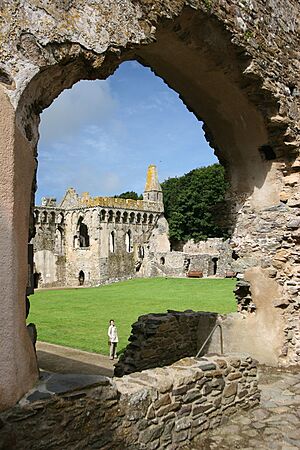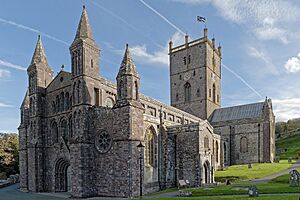St Davids Cathedral facts for kids
Quick facts for kids Saint Davids Cathedral |
|
|---|---|
|
Eglwys Gadeiriol Tyddewi
|
|
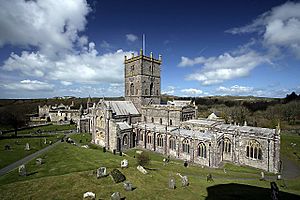
St Davids Cathedral from the gatehouse (April 2008)
|
|
| 51°52′55″N 5°16′06″W / 51.88194°N 5.26833°W | |
| Location | St Davids, Pembrokeshire |
| Country | Wales |
| Denomination | Church in Wales |
| Previous denomination | Roman Catholic |
| History | |
| Authorising papal bull | 1123 |
| Founded | c. AD 589 |
| Founder(s) | St David |
| Consecrated | 1131 |
| Relics held | St David |
| Architecture | |
| Architect(s) | Medieval masons John Nash (18th century) George Gilbert Scott (19th century) |
| Style | Romanesque architecture, English Gothic architecture |
| Groundbreaking | 1181 |
| Completed | Mid-13th century |
| Specifications | |
| Length | 90 metres (300 ft) |
| Nave width | 22.5 metres (74 ft) |
| Height | 35 metres (115 ft) |
| Administration | |
| Diocese | St Davids |
St Davids Cathedral (in Welsh: Eglwys Gadeiriol Tyddewi) is a beautiful cathedral belonging to the Church in Wales. It is located in St Davids, which is the smallest city in Britain. The city is found in the county of Pembrokeshire, near the most western point of Wales.
Contents
The Cathedral's Early History
A Holy Place is Founded
Around the year 589, a holy man named Saint David founded a monastery here. A monastery is a place where religious people called monks live and work together. For hundreds of years, this community was a target for raiders, including the Vikings.
Despite these attacks, St Davids became famous as a center for religion and learning. Even King Alfred of Wessex asked for help from the monks at St Davids to improve education in his kingdom. Sadly, many bishops were killed during raids, including Bishop Abraham in 1080. A special carved stone that marked his grave, called the "Abraham Stone," can still be seen in the cathedral today.
In 1081, the famous king William the Conqueror visited St Davids to pray. This showed that he recognized it as a very important and holy place.
Becoming a Place of Pilgrimage
In 1115, King Henry I of England chose a man named Bernard to be the new bishop. Bishop Bernard started building a new, grander cathedral. In 1123, he asked the Pope in Rome to make St Davids an official center for pilgrimage. A pilgrimage is a special journey people make to a holy site.
The Pope agreed and made a famous declaration: "Two pilgrimages to St Davids is equal to one to Rome, and three pilgrimages to one to Jerusalem." This made St Davids incredibly popular, and the new cathedral was finished and blessed in 1131.
A Bigger and Better Cathedral
When King Henry II of England visited in 1171, even more people became devoted to St David. It was clear that a larger cathedral was needed. The building we see today was started in 1181. However, it had some early problems. The tower collapsed in 1220, and an earthquake caused damage in 1247.
Over the years, different bishops added new features. Bishop Gower (1328–1347) built the beautiful Bishops Palace next to the cathedral, which is now a stunning ruin. Bishop Edward Vaughan (1509–1522) added the Holy Trinity chapel, which has a special arched ceiling called a fan vault.
During this time, the father of King Henry VII, Edmund Tudor, was buried in front of the high altar. His tomb is still there.
The Cathedral in Modern Times
If you walk inside the cathedral, you might notice that the floor slopes. There is a difference of almost four meters in height from one end to the other! The building is still slowly shifting even today.
Restoration and Royal Visits
Over the centuries, parts of the cathedral fell into disrepair. In 1793, the architect John Nash was hired to fix the west front. Unfortunately, his work wasn't very good and had to be redone about 100 years later by another famous architect, George Gilbert Scott.
The 20th century brought many changes. In 1981, Charles, Prince of Wales, visited to celebrate the 800th anniversary of the cathedral. In 1982, Queen Elizabeth II visited to hand out the Royal Maundy money, a special Easter tradition. It was the first time this ceremony had ever happened outside of England.
In 1995, the Queen officially gave St Davids the status of a "city" again, making it Britain's smallest city.
Major Projects for the New Millennium
Starting in the 1990s, the cathedral underwent huge restoration projects. The west front was repaired using stone from the original quarry. A new organ was built and dedicated in 2000.
The old gatehouse, called Porth y Twr, now holds the cathedral's bells. The original eight bells were joined by two new ones in 2000. The old monastery cloisters (covered walkways) were also rebuilt. They now house a café, meeting rooms, and an education center, connecting the cathedral's present to its past.
Life at the Cathedral Today
St Davids is a busy, living church. Services are held every day of the week.
The Cathedral Choirs
The cathedral is famous for its choir. It was the first cathedral in the UK to use girls as its main singers, along with men. There is also a boys' choir that sings regularly.
The St Davids Cathedral Festival
Every year, the cathedral hosts a music festival. It attracts amazing performers from all over the world. The cathedral's own choirs are always a popular part of the festival.
Local Legends
The Talking Stone
A writer from the 13th century named Gerald of Wales told a strange story about a marble footbridge near the cathedral. The stone was called Llechllafar, which means "the talking stone." The legend says that when a body was being carried over it for burial, the stone spoke and then cracked from the effort. People became so superstitious that they stopped carrying bodies over the bridge. The bridge was replaced in the 16th century, and no one knows where the talking stone is now.
Merlin's Prophecy
Another legend says that the wizard Merlin predicted that a king of England, who had conquered Ireland, would die on the Llechllafar stone. When King Henry II visited St Davids after coming from Ireland, he heard the story. He bravely crossed the stone and was unharmed. He boasted that Merlin was a liar. But a person in the crowd pointed out that Henry had not conquered all of Ireland, so he wasn't the king in the prophecy.
Famous People Buried at the Cathedral
Many important people from history are buried in the cathedral, including:
- Rhys ap Gruffydd (A powerful Welsh prince)
- Gerald of Wales (A famous medieval writer)
- Edmund Tudor, 1st Earl of Richmond (Father of King Henry VII)
See also
 In Spanish: Catedral de San David para niños
In Spanish: Catedral de San David para niños


